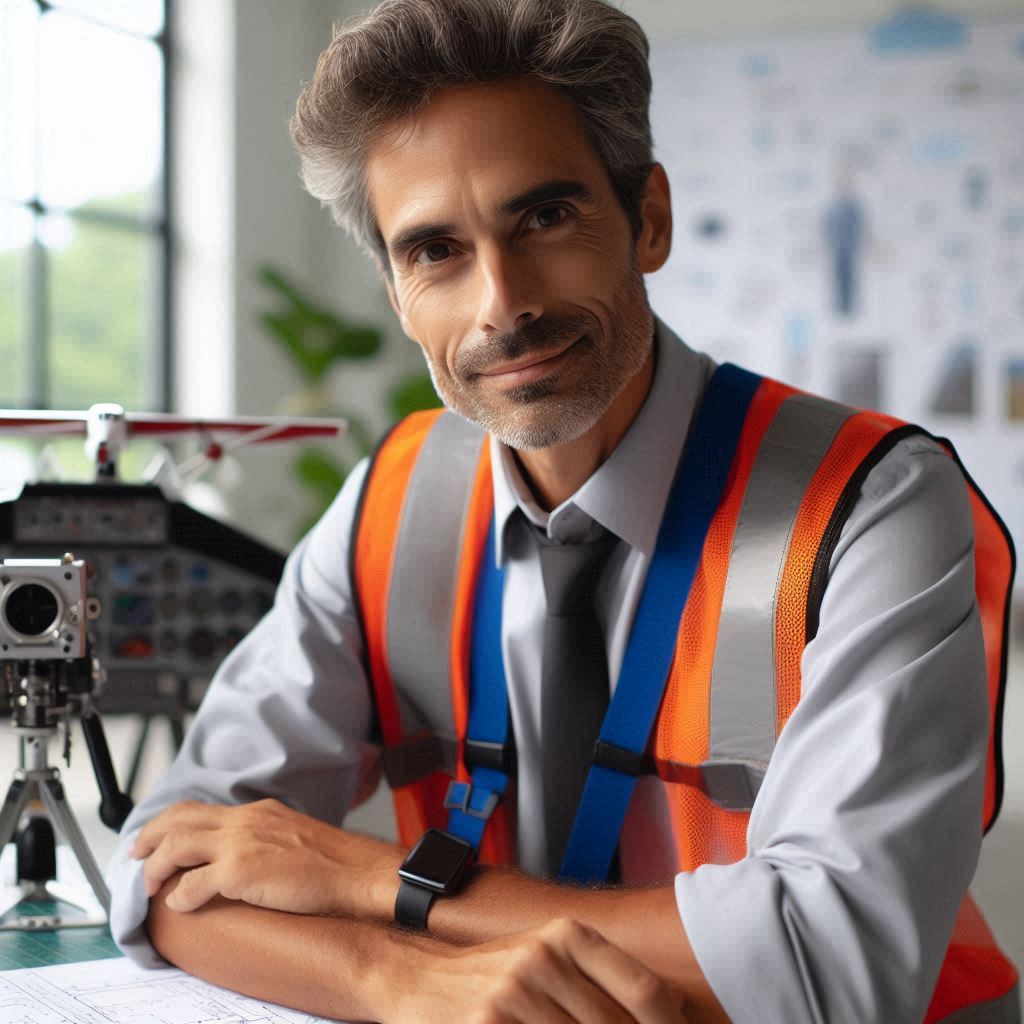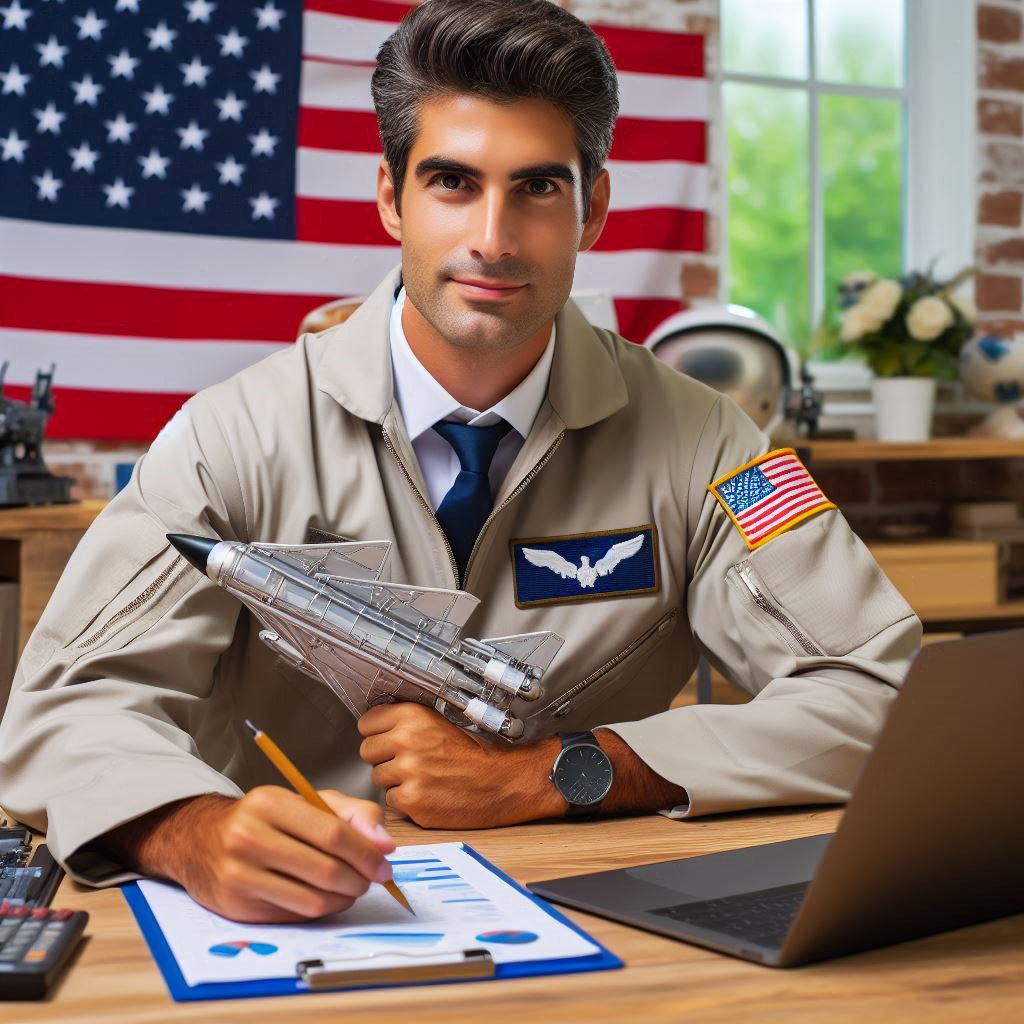Introduction
An aerospace engineer designs, develops, and tests aircraft and spacecraft, ensuring they meet safety, efficiency, and performance standards.
They work on a variety of projects, from commercial jets to cutting-edge space missions.
Their tasks include analyzing complex systems, solving engineering problems, innovating new technologies to push the boundaries of aviation and space travel.
Aerospace engineering holds significant importance in both the aviation and space industries.
In aviation, aerospace engineers enhance aircraft performance, focusing on factors such as fuel efficiency, aerodynamics, and safety.
Their work leads to the development of advanced, environmentally friendly jets that meet the demands of modern air travel.
In the realm of space exploration, aerospace engineers are crucial for designing spacecraft that can withstand the harsh conditions of space.
They contribute to missions that launch satellites, explore distant planets, and support scientific research beyond Earth‘s atmosphere.
Their expertise helps achieve ambitious goals, from landing humans on the Moon to sending rovers to Mars.
The field of aerospace engineering plays a pivotal role in driving technological advancements and ensuring the success of vital missions.
Aspiring engineers in this field have the opportunity to shape the future of both aviation and space exploration.
By pursuing a career as an aerospace engineer, individuals can contribute to transformative projects and innovations that impact the world and beyond.
Education and Qualifications
Bachelor’s Degree in Aerospace Engineering or Related Field
To become an aerospace engineer, start by earning a bachelor’s degree in aerospace engineering or a related field.
This foundational education provides the essential knowledge required for a career in aerospace engineering.
Universities offer programs that cover subjects such as aerodynamics, propulsion, and materials science.
Courses also include fluid dynamics and structural analysis.
During your undergraduate studies, you will engage in hands-on projects and internships.
These practical experiences are crucial for applying theoretical knowledge to real-world problems.
They also help you build a professional network, which can be invaluable in your future career.
Graduate Degree for Advanced Positions
For advanced positions or specialized roles, consider pursuing a graduate degree.
A master‘s or Ph.D. in aerospace engineering or a related field can significantly enhance your career prospects.
Graduate programs offer advanced coursework and research opportunities.
They allow you to focus on specific areas such as spacecraft design or advanced propulsion systems.
A graduate degree can open doors to roles in research, development, and academia.
It also prepares you for leadership positions within the aerospace industry.
Advanced degrees are especially beneficial for careers in high-tech areas or for those aiming to contribute to cutting-edge innovations.
Skills Required: Math, Physics, Computer Science
In addition to formal education, developing certain skills is crucial for success as an aerospace engineer.
Strong mathematical skills are essential. Aerospace engineers frequently use calculus, differential equations, and linear algebra to solve complex problems.
Proficiency in physics is equally important, as it helps in understanding the principles of flight and material behavior.
Computer science skills are also vital.
Aerospace engineers often use computer-aided design (CAD) software and simulation tools.
Knowledge of programming languages, such as MATLAB or Python, is beneficial for analyzing data and developing algorithms.
These skills help engineers model and test designs effectively.
Practical Experience and Continuous Learning
Gaining practical experience through internships or co-op programs is crucial.
These experiences provide insight into the day-to-day tasks of an aerospace engineer.
They also enhance your problem-solving skills and allow you to work on real projects.
Continuous learning is essential in this ever-evolving field.
Stay updated with the latest technological advancements and industry trends.
Professional certifications or attending workshops can further enhance your expertise and career growth.
Becoming an aerospace engineer requires a strong educational foundation and a set of critical skills.
Begin with a bachelor’s degree in aerospace engineering or a related field.
Consider advancing your education with a graduate degree for specialized roles.
Cultivate essential skills in math, physics, and computer science.
Practical experience and ongoing learning will further prepare you for a successful career.
By following these steps, you can pave the way to a fulfilling career in aerospace engineering, contributing to innovations in flight and space exploration.
Gain Experience
Internships or Co-op Programs with Aerospace Companies
Securing internships or co-op programs with aerospace companies provides invaluable real-world experience.
These opportunities offer hands-on involvement in aerospace projects.
They allow you to apply classroom knowledge to practical problems and gain industry insights.
Working directly with aerospace professionals helps you understand industry standards and practices.
Internships often involve working on actual engineering tasks, such as designing components or analyzing data.
This experience enhances your resume and makes you more competitive in the job market.
Additionally, networking with industry professionals during these programs can lead to job offers or valuable references.
Research Opportunities in University Labs
Engaging in research within university labs is another key step toward becoming an aerospace engineer.
Many universities offer research opportunities in aerospace-related fields.
Working on research projects allows you to explore cutting-edge technologies and contribute to scientific advancements.
University labs provide access to advanced equipment and resources.
Collaborating with professors and graduate students on research projects helps build your technical skills.
It also demonstrates your commitment to the field and can lead to publications or conference presentations.
Joining Aerospace Engineering Clubs or Organizations
Joining aerospace engineering clubs or organizations is an excellent way to enhance your education and career prospects.
These clubs offer networking opportunities, workshops, and seminars.
Participating in these activities helps you stay informed about industry trends and innovations.
Clubs often organize hands-on projects and competitions, such as designing model rockets or aircraft.
These projects help you apply theoretical knowledge in practical settings and develop teamwork skills.
Being active in these organizations also allows you to connect with like-minded peers and mentors.
Combining These Strategies for Success
Integrating internships, research, and club participation creates a well-rounded aerospace engineering profile.
Internships provide practical experience, research enhances technical skills, and clubs offer networking opportunities.
Together, these experiences build a strong foundation for a successful aerospace engineering career.
Maximizing Your Opportunities
To maximize the benefits of these experiences, start by researching available internships and co-op programs early.
Seek out research opportunities through your university‘s engineering department or faculty members.
Get involved in aerospace clubs or organizations as soon as you start your academic journey.
Make sure to stay proactive and engaged.
Apply for multiple internships, attend club meetings regularly, and take initiative in research projects.
Each experience builds upon the last, contributing to your overall growth as an aerospace engineer.
Becoming an aerospace engineer requires a combination of academic knowledge and practical experience.
Internships, research opportunities, and club involvement are essential elements of this journey.
By actively pursuing these opportunities, you prepare yourself for a successful career in aerospace engineering.
These experiences not only enhance your skills but also expand your professional network.
Embrace every opportunity to learn and grow, and you will be well on your way to achieving your aerospace engineering goals.
Specializations in Aerospace Engineering
Aerodynamics
Aerodynamics is the study of how air interacts with solid objects, such as aircraft.
It involves analyzing airflow around wings and fuselages.
Mastering aerodynamics is crucial for designing efficient, high-performance aircraft.
Engineers use wind tunnels and computer simulations to study aerodynamic properties.
This knowledge helps in reducing drag and improving fuel efficiency.
Transform Your Career Today
Unlock a personalized career strategy that drives real results. Get tailored advice and a roadmap designed just for you.
Start NowPropulsion Systems
Propulsion systems are responsible for moving aircraft through the air.
This includes engines and thrust mechanisms.
Aerospace engineers must understand how jet engines and rocket motors work.
They study principles of combustion, thrust generation, and energy conversion.
Advanced propulsion systems aim for higher efficiency and lower environmental impact.
Engineers also work on integrating these systems with aircraft structures.
Avionics
Avionics refers to the electronic systems used in aircraft for navigation, communication, and control.
It includes radar, GPS, and flight control systems.
Aerospace engineers design and implement avionics to enhance safety and operational efficiency.
They work on integrating complex electronic systems and ensuring their reliability under various conditions.
Modern avionics also support advanced automation and data analysis.
Structures and Materials
Structures and materials focus on the physical components of aircraft, including wings, fuselages, and landing gear.
Aerospace engineers study the properties of materials like composites and metals.
They design structures to withstand extreme conditions, such as high speeds and varying temperatures.
Engineers must ensure that these components are both strong and lightweight.
This balance is critical for overall aircraft performance.
The Interplay Between Disciplines
Each area of study in aerospace engineering is interconnected.
Aerodynamics, propulsion systems, avionics, and structures must work together seamlessly.
An understanding of how these systems interact is essential for creating effective and safe aircraft.
Engineers often collaborate across these disciplines to solve complex problems and innovate.
Educational Pathways
To pursue a career in aerospace engineering, one must typically earn a bachelor‘s degree in aerospace engineering or a related field.
Advanced degrees and specialized certifications can further enhance expertise.
Coursework and hands-on projects in aerodynamics, propulsion, avionics, and materials are crucial.
Internships and co-op programs provide practical experience and industry insights.
Becoming an aerospace engineer requires a deep understanding of various technical areas.
Mastery of aerodynamics, propulsion systems, avionics, and structures is essential.
Each discipline contributes to the design, efficiency, and safety of aircraft.
A strong educational foundation, coupled with practical experience, prepares engineers for the challenges and innovations in aerospace engineering.
Read: How to Become a Civil Rights Advocate
Certifications and Licenses
Professional Engineer (PE) License
Getting a Professional Engineer (PE) license is an essential step for aerospace engineers who want to advance their careers.
This license demonstrates that you have met the requirements set by the licensing board to practice engineering in your state or country.
Having a PE license can open up opportunities for higher-paying positions, supervisory roles, increased responsibilities within the field of aerospace engineering.
To obtain a PE license, you typically need to have a bachelor’s degree in engineering from an accredited program, pass the Fundamentals of Engineering (FE) exam.
Gain relevant work experience under the supervision of a licensed PE, and then pass the Principles and Practice of Engineering (PE) exam.
The specifics of the licensing process may vary depending on your location, so be sure to research the requirements in your area.
Optional Certifications
In addition to the PE license, aerospace engineers may choose to pursue optional certifications in specific areas of aerospace engineering to demonstrate their expertise and enhance their credentials.
These certifications can help you stand out in a competitive job market, increase your earning potential, and stay current with advancements in the field.
Some examples of optional certifications in aerospace engineering include the Certified Aerospace Engineer (CAE) designation.
Offered by professional organizations like the American Institute of Aeronautics and Astronautics (AIAA.
)Certifications in specialized areas such as aerodynamics, propulsion, avionics, or systems engineering.
Each certification may have its own requirements, such as passing an exam or completing a certain number of continuing education credits.
Be sure to research the certifications that align with your career goals and interests.
Certifications and licenses play a crucial role in the career development of aerospace engineers.
The Professional Engineer (PE) license can open up new opportunities for advancement.
While optional certifications allow engineers to specialize in specific areas and demonstrate their expertise to employers.
By pursuing these credentials, aerospace engineers can enhance their careers.
Increase their earning potential, and stay competitive in the dynamic field of aerospace engineering.
Read: Iconic US Buildings and the Architects Behind Them.
Develop Technical Skills
Developing technical skills is crucial for aspiring aerospace engineers as it forms the foundation for successful career growth in the field.
Let’s take a closer look at the technical skills that are essential to excel in this profession.
Proficiency in CAD Software
Having a strong command of computer-aided design (CAD) software is a fundamental skill for aerospace engineers.
CAD programs are used to create 2D and 3D models of aircraft, spacecraft, and their components.
Engineers use CAD software to design and visualize complex structures, analyze performance, and simulate various scenarios.
Proficiency in CAD tools such as SolidWorks, AutoCAD, or CATIA is essential for creating detailed and accurate designs.
Understanding of Aerodynamics and Fluid Dynamics
Aerospace engineers must have a deep understanding of aerodynamics and fluid dynamics to design efficient and aerodynamically sound aircraft and spacecraft.
Aerodynamics deals with the study of airflow around objects, while fluid dynamics focuses on the behavior of fluids in motion.
Engineers use this knowledge to optimize the shape and performance of aircraft components, such as wings, fuselage, and control surfaces.
By applying principles of aerodynamics and fluid dynamics, engineers can improve fuel efficiency, reduce drag, and enhance overall performance.
Knowledge of Propulsion Systems and Materials Science
Aerospace engineers need to have a solid grasp of propulsion systems and materials science to develop cutting-edge aerospace technologies.
Propulsion systems are essential components of aircraft and spacecraft that generate thrust to propel them forward.
Engineers must understand the principles of propulsion and the operation of engines, rockets, and turbines.
Additionally, knowledge of materials science is crucial for selecting the right materials to withstand extreme conditions in space and aviation.
Aerospace engineers should be familiar with the properties of materials, such as composites, alloys, and ceramics, to design lightweight yet durable structures.
Therefore, developing technical skills in CAD software, aerodynamics, fluid dynamics, propulsion systems.
Materials science is essential for aspiring aerospace engineers to succeed in the competitive industry.
By honing these skills through education, hands-on experience, and continuous learning.
Engineers can contribute to innovative aerospace projects and advance the future of aviation and space exploration.
Read: Post-Pandemic Design Trends: US Architects Adapt

Networking and Professional Development
Networking and professional development are crucial aspects for individuals looking to become successful aerospace engineers.
By participating in various activities and events, aspiring engineers can expand their knowledge, build connections, and enhance their career prospects.
Attending Aerospace Engineering Conferences and Workshops
One of the best ways to stay updated on the latest trends and advancements in the aerospace industry is by attending conferences and workshops.
These events provide a platform for engineers to share ideas, learn from experts, and engage in discussions about cutting-edge technologies.
Conferences and workshops also offer valuable networking opportunities.
Allowing engineers to connect with industry professionals, potential employers, and like-minded individuals.
By actively participating in these events, aerospace engineers can broaden their knowledge base.
Gain insights into emerging technologies, and stay ahead of the curve in this highly competitive field.
Importance of Joining Professional Organizations
Professional organizations like the American Institute of Aeronautics and Astronautics (AIAA).
The Society of Automotive Engineers (SAE) play a significant role in the aerospace engineering community.
By becoming a member of these organizations, engineers gain access to a wealth of resources, including industry publications, and networking opportunities.
Showcase Your Business Today
Reach thousands of readers actively exploring professional services. Publish your business profile and grow your audience now.
Publish NowMembership in professional organizations also demonstrates a commitment to professional development and continuous learning.
Which can enhance credibility and open doors to new career opportunities.
Additionally, engineers can benefit from mentorship programs, career guidance, and job placement services offered by these organizations.
Networking for Job Opportunities
Networking is a powerful tool for aerospace engineers seeking job opportunities.
By building relationships with professionals in the field, engineers can access hidden job markets.
Gather valuable insights about potential employers, and receive referrals for open positions.
Attending industry events, such as career fairs, company visits, and networking sessions, can help engineers showcase their skills.
Make a positive impression on recruiters, and increase their chances of landing their dream job.
Networking also allows engineers to stay connected with industry trends, stay informed about job openings in the aerospace sector.
Most Importantly, networking and professional development are essential components of a successful aerospace engineering career.
By actively participating in conferences, joining professional organizations, and networking with industry professionals.
Aspiring engineers can enhance their skills, expand their knowledge base, and unlock new opportunities in this dynamic and fast-paced industry.
Read: Economic Indicators and Their Influence on US Architects
Learn More: Roles and Duties of Geological Technicians Explained
Job Search and Application Process
Looking for a job in the aerospace industry can be an exciting but challenging process.
Here are some key steps to help you navigate the job search and application process effectively:
Researching Aerospace Companies and Government Agencies
To pursue a career in aerospace engineering, start by researching aerospace companies and government agencies.
Understand their missions, projects, and areas of specialization.
This knowledge helps in targeting the right organizations that align with your career goals.
Major aerospace companies include Boeing, Lockheed Martin, and SpaceX.
Government agencies such as NASA and the FAA also play crucial roles in the industry.
Look into the types of aerospace engineering roles available at these organizations.
This information helps in identifying which positions match your skills and interests.
Research their recent projects and technological advancements to stay informed about the latest industry trends.
Tailoring Resume and Cover Letter to Highlight Relevant Experience
Once you identify potential employers, tailor your resume and cover letter to highlight relevant experience.
Customize your resume to emphasize your educational background, internships, and any projects related to aerospace engineering.
Use specific examples to demonstrate your skills in areas like aerodynamics, propulsion, or materials science.
Your cover letter should address the specific company and role you are applying for.
Highlight how your skills and experiences align with their needs and goals.
Personalize your cover letter by mentioning any research you have done about the company and how you can contribute to their projects.
Preparing for Technical Interviews and Assessments
Preparing for technical interviews and assessments is crucial for landing a job in aerospace engineering.
Start by reviewing fundamental concepts in math, physics, and engineering principles.
Practice solving problems related to aerodynamics, structural analysis, and propulsion systems.
Familiarize yourself with common interview formats, such as technical questions, problem-solving exercises, and design challenges.
Some interviews may include practical assessments where you demonstrate your technical skills.
Review past interview questions and practice with mock interviews to build confidence.
Additionally, prepare to discuss your previous projects and internships.
Be ready to explain your role, the challenges you faced, and the solutions you implemented.
Demonstrating problem-solving abilities and technical expertise is key to making a strong impression.
Building a Professional Network
Networking with professionals in the aerospace industry can provide valuable insights and opportunities.
Attend industry conferences, seminars, and workshops to connect with experts and potential employers.
Join aerospace engineering organizations and online forums to stay updated and engaged.
Networking can also lead to mentorship opportunities.
Seek advice from experienced professionals who can guide you through your career development.
Their insights can be invaluable for understanding industry expectations and advancing your career.
To become an aerospace engineer, research aerospace companies and government agencies to identify potential employers.
Tailor your resume and cover letter to highlight relevant experience and align with job requirements.
Prepare thoroughly for technical interviews and assessments by reviewing fundamental concepts and practicing problem-solving skills.
Building a professional network and staying informed about industry trends will further enhance your career prospects.
By following these steps, you can effectively navigate the job search process and position yourself for success in the aerospace engineering field.
Gain More Insights: Aerospace Engineering in Defense Industry
Conclusion
To become an aerospace engineer, follow several key steps.
First, earn a relevant degree, such as aerospace engineering, mechanical engineering, or a related field.
This educational foundation provides the theoretical knowledge necessary for the profession.
Next, gain hands-on experience through internships or co-op programs, which offer practical insights and industry exposure.
Practical experience helps bridge the gap between academic learning and real-world applications.
Additionally, developing essential technical skills, including proficiency in software like CAD/CAM, Matlab, and ANSYS, is crucial for success.
Pursuing a career in aerospace engineering offers exciting opportunities to contribute to the advancement of aviation and space exploration.
Aerospace engineers are at the forefront of designing and improving aircraft and spacecraft, playing a pivotal role in pushing the boundaries of technology.
Their work impacts everything from commercial air travel to interplanetary exploration.
Continuous learning and professional development are essential in this dynamic field.
Aerospace technology evolves rapidly, and staying updated with the latest advancements is critical.
Obtaining relevant certifications, attending industry conferences, and engaging in ongoing education will help you remain competitive and effective.
Embrace opportunities for growth and innovation, as they are key to achieving long-term success and satisfaction in aerospace engineering.
By committing to continuous learning and adapting to new challenges, you will position yourself as a leader in this exciting and ever-evolving field.
[E-Books for Sale]
The Big Book of 500 High-Paying Jobs in America: Unlock Your Earning Potential
$19.99 • 500 High-Paying Jobs • 330 pages
Explore 500 high-paying jobs in America and learn how to boost your career, earn more, and achieve success!
See All 500 High-Paying Jobs of this E-Book
1001 Professions Without a Degree: High-Paying American Jobs You Can Start Now
$19.99 • 1001 Professions Without a Degree • 174 pages
Discover 1001 high-paying jobs without a degree! Unlock career tips, skills, and success strategies for just $19.99!




